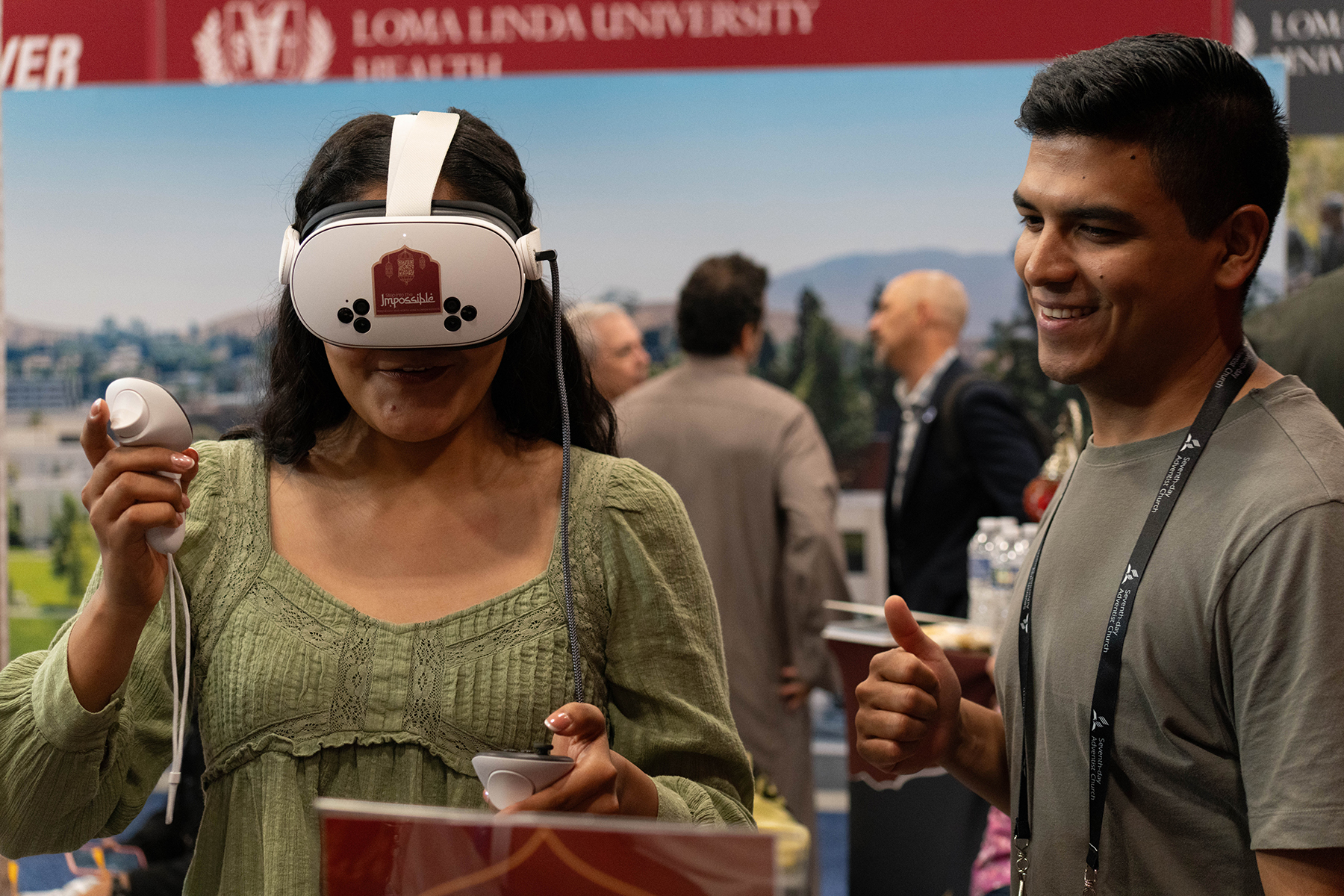
During the 62nd GC Session in St. Louis, Mo., visitors to the Middle East and North Africa Union (MENAUM) booth virtually explored countries across the region.
At the 62nd General Conference Session, a small audience looked on as Phil and Paul — Walla Walla University’s custom-made bioengineering robots — collaborated with seamless precision. Designed by WWU students, Phil created microscopic tissue scaffolding while Paul manipulated a ping pong ball, inscribed it with ‘WW,’ and dropped it down a chute. But this wasn’t just an entertaining demo; it represented the university’s groundbreaking tissue engineering research.
Bioengineering students use the same scaffolding, called a matrix, by seeding the matrix with cells and manipulating them to grow functional human muscle tissue. “If you've got a big chunk taken out of your arm, [you] can't do skin grafts for that,” explained Jodi Wagner, Walla Walla’s vice president for marketing. “You need more muscle tissue than your body can provide. So something similar to this can be helpful.”
Walla Walla’s booth focusing on its science departments was one of several in the GC exhibit hall exemplifying the interaction of innovation, faith, and service.
A Quiet Witness through Science
“If it’s engineering, it’s Walla Walla,” stated president Alex Bryan. Their alums work for top organizations including NASA, Lockheed Martin, and Amazon. Still, more significantly, said Jodi Wagner, WWU’s vice president for marketing and enrollment services, “We’re building engineers of faith so they can go out and bless all parts of our lives. They’ve got hearts of service.”
That spirit of service fuels student projects, from designing attachments for Maranatha’s One-Day churches to installing radio towers in remote islands and assisting with water purification via Engineering without Borders.
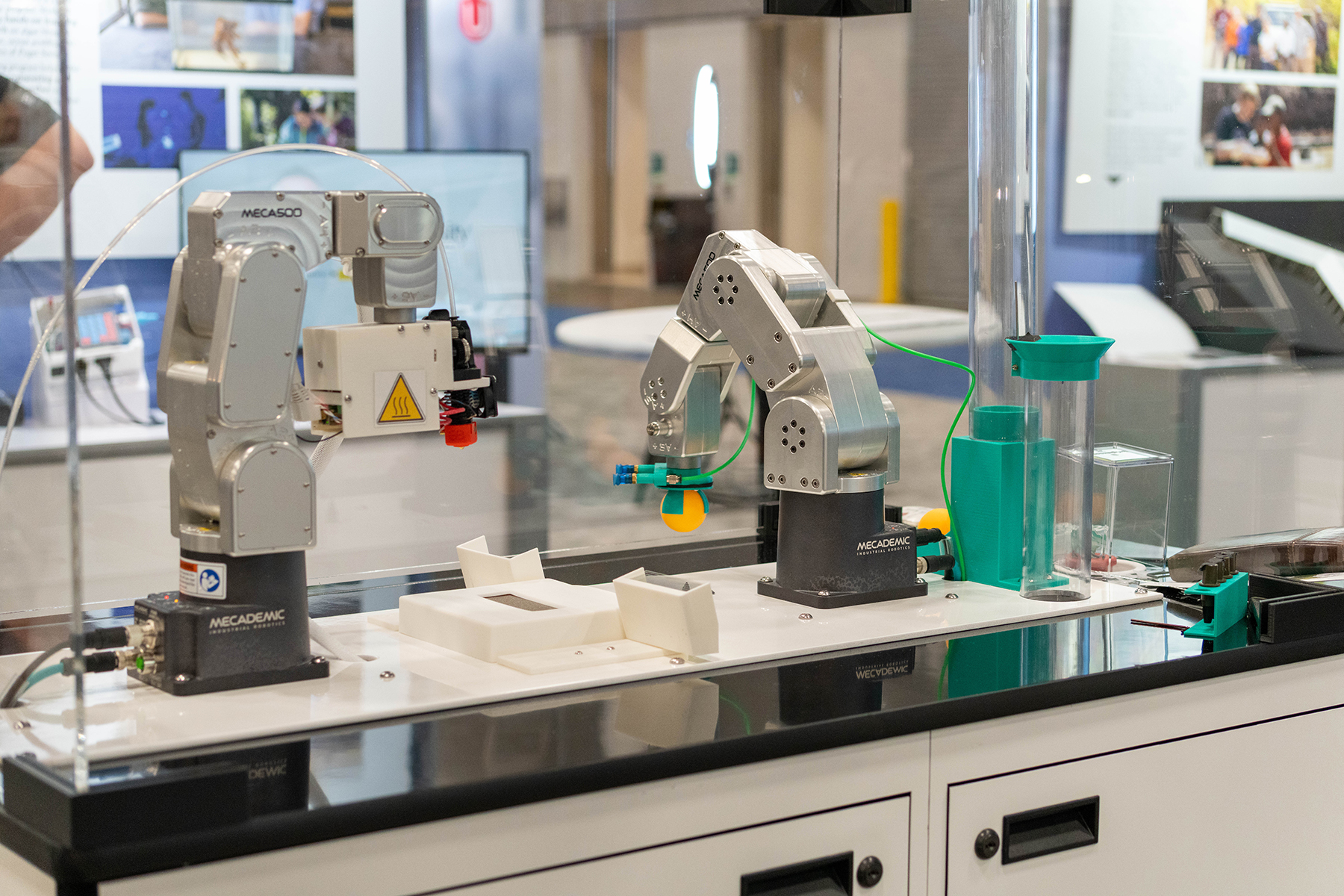
Walla Walla University’s student-designed robots, Phil and Paul, showcase tissue engineering research in action during the GC Session exhibit. Photo: Caleb Durant | North American Division
Wagner emphasized, “If we have people on the forefront of these science areas, we benefit — not only because of the products they create, but [also from] the witness they can be in those areas. That’s an incredible opportunity to witness in quiet, reverent ways.”
[Click here to read more about Walla Walla University's unique marine biology program, also featured at the GC Session exhibits.}
Technology Expanding Ministry Reach
IATec (Adventist Institute of Technology) demonstrated how innovation can expand ministry effectiveness in another corner of the hall. Based in Brazil, Bolivia, and Peru, IATec offers technological solutions in education, finance, human resources, and other church operations, primarily within the South American Division.
Through a partnership with the General Conference, they operate the Adventist Church Management System (ACMS), the official global membership and treasury system, and the 7me app, a personalized mobile platform connecting members to their local church, giving, events, and spiritual resources.
“IA Tech was the first institute of the church in this area,” said project manager Wilson Carlos Da Silva. “Churches [and] schools can use these solutions to help complete the mission and spread the gospel to people who do not know about Jesus Christ and His salvation.”
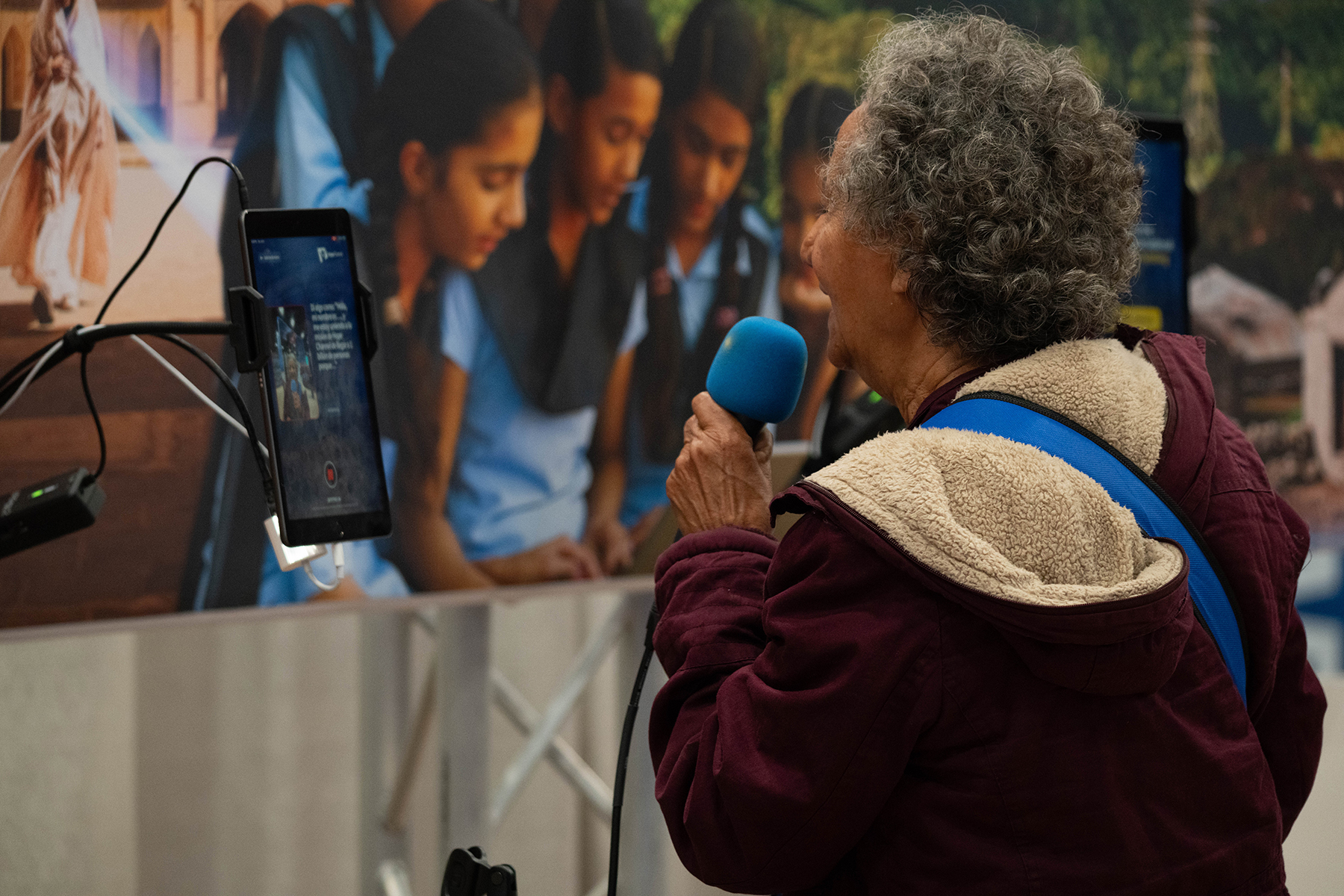
A visitor to the GC Session exhibits explores Hope Channel’s AI dubbing tool, Jetstream Voice Dubbing, which can translate messages into multiple languages within minutes. Photo: Caleb Durant | North American Division
Reaching the Unreached through AI
At the Hope Channel International booth, visitors lined up to test a hands-on demo of Jetstream Voice Dubbing, an AI-powered tool that translates a recorded message into other languages. After recording a 30-second message in two dubbing languages, they received the translated video via email in less than 15 minutes. Jetstream is part of Adventist Cloud, an online platform offering free products to church entities, including Adventist Media Exchange, personnel management, and content scheduling.
Jonathan Demyan, a third-year theology student and exhibitor, spoke to this tool’s usefulness in reaching the 10/40 window.* “We are using tools like this to reach people where they are, if we can’t go there physically, if it’s dangerous, or there aren’t enough workers there,” he said.
He affirmed, “Hope Channel is trying to use new tools to adapt to the world we live in and reach as many people as we can. Our goal is to reach 1 billion people by 2030.”
Spirit-led Innovation in Media
At the booth for 7Play — a media project within the South American Division’s communication department — children gathered around tablets streaming Bible-based content. The team describes its growing catalog of movies, series, and documentaries for children and youth as a free, Seventh-day Adventist version of Netflix.
New content is released every Friday at 7 p.m., with programming ranging from an animated series on the writings of Ellen G. White to Pathfinder-themed films. Most content is available in Portuguese and Spanish, with select programs offered in English on YouTube.
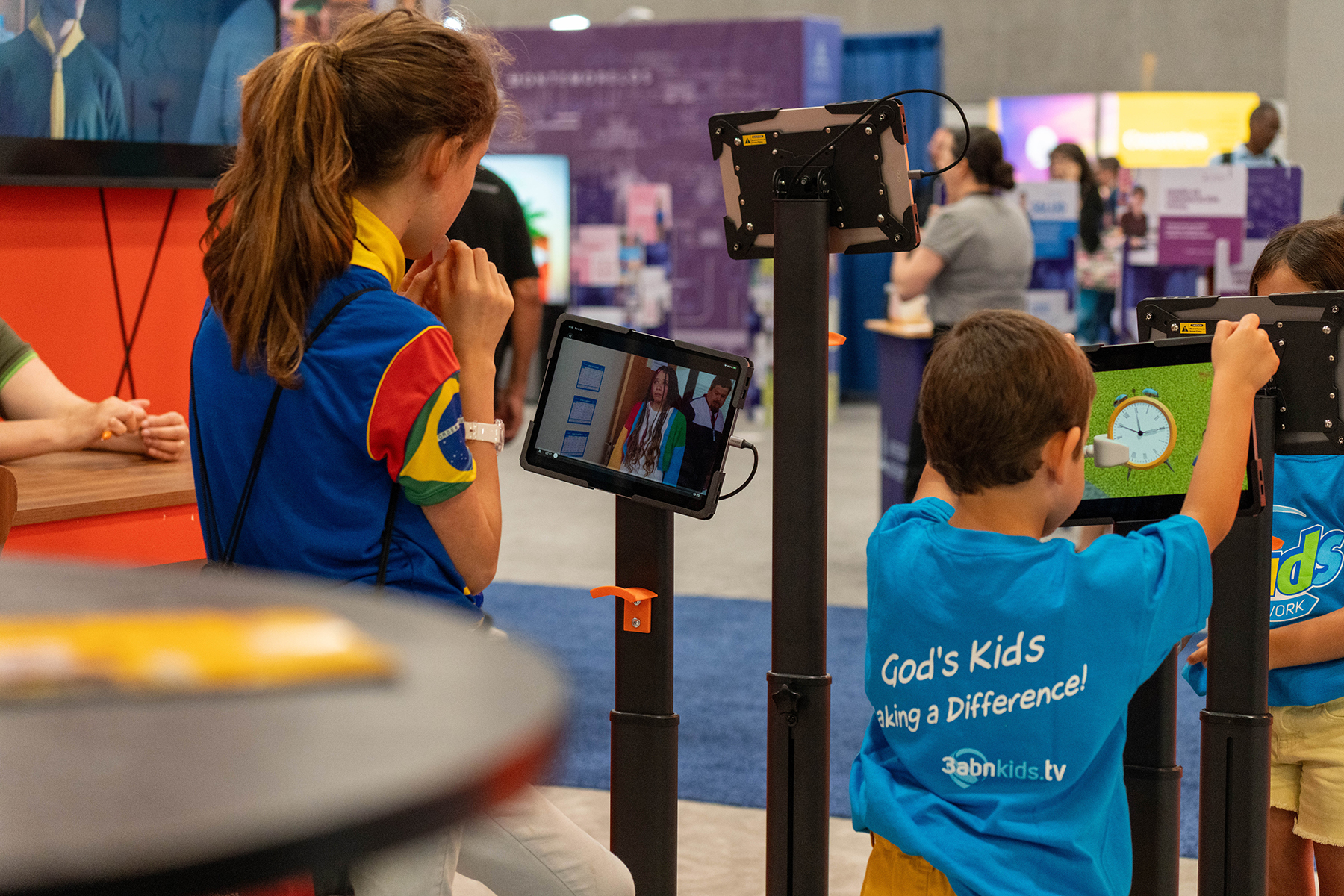
At the 7Play booth, young visitors enjoy Bible-based programming on mounted iPads. Photo: Caleb Durant | North American Division
Once known as Feliz7Play (a play on “Happy Sabbath” in Spanish), the ministry now serves more than 40 percent non-Adventist viewers, some from other denominations, others unchurched.
“We hear stories from people who know the church through our movies. After watching, they look for a church,” said executive producer Kimberly Dias. “And people are using our content to evangelize — even in the jails.”
Goggles and the Gospel: Immersive Technology for Mission
The Inter-American Division Theological Seminary booth showcased a unique immersive virtual reality tool called The TheoVerse Legacy. It was designed to teach complex theological topics (i.e., creationism and evolution) through visual storytelling.
Visitors to the exhibits entered the first virtual chapter, “experiencing” each day of creation through interactive scenes and video game-like challenges. The virtual reality experience incorporated pauses for professor-led discussions facilitated by a companion book.
While the tool rolled out only four months ago, the division’s education department has already asked the seminary to make it available to all their schools. Other countries also showed interest after visiting the exhibit.
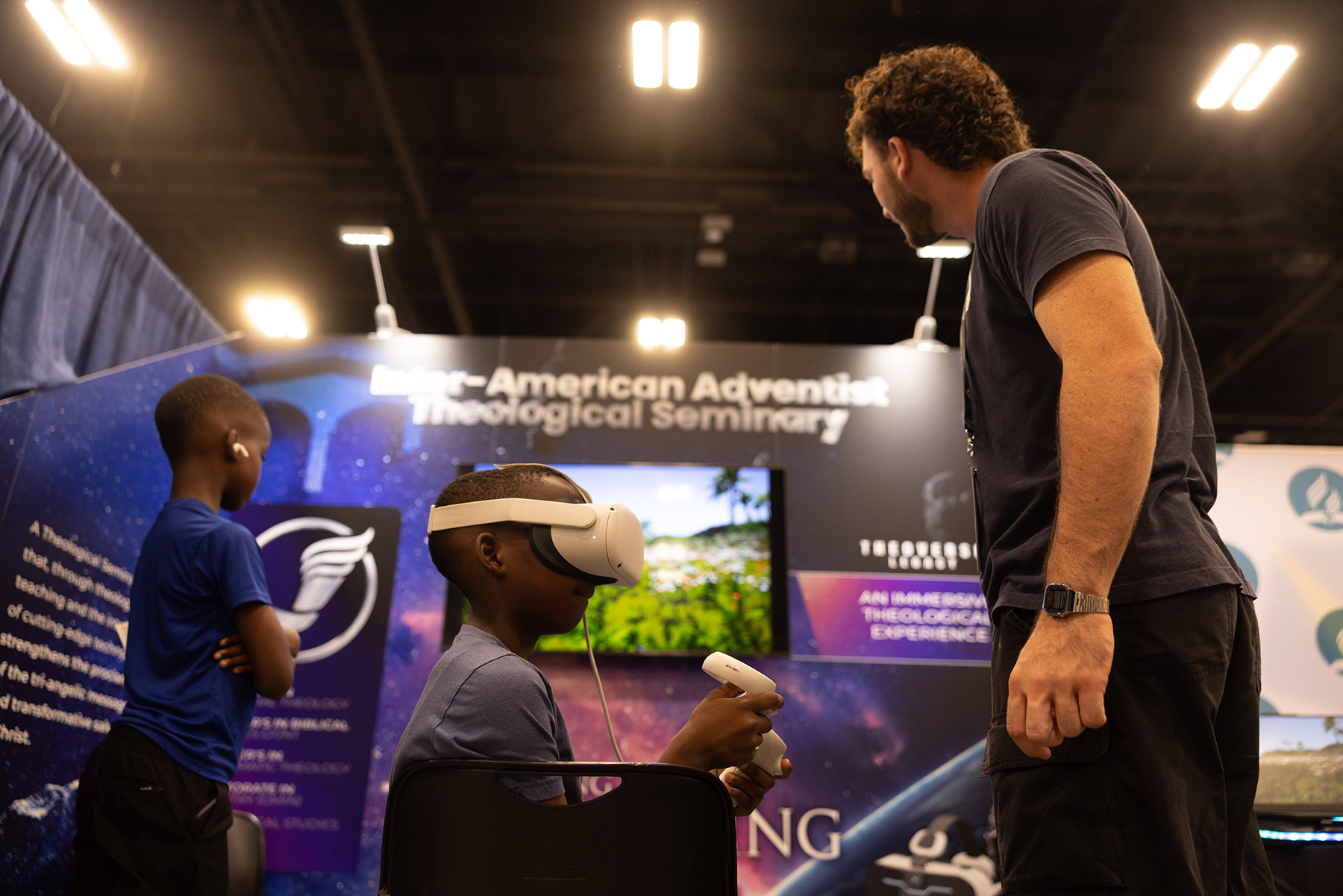
A young boy uses a virtual reality headset to explore “The TheoVerse Legacy,” an immersive Bible study tool developed by the Inter-American Division Theological Seminary. Photo: Daniel Gallordo | Inter-American Division
Project lead Carlos Robles, the seminary’s president of institutional effectiveness, strategic planning, and business education, shared that he and a seminary student/app designer created the program over two years with the financial backing of Adventist and non-Adventist partners. Before then, a committee of scientists, educators, and theologians fleshed out the content.
Robles explained their motivation as deepening learning beyond lectures and reading: “We believe people remember what they experience.”
A Virtual Window into Unreached Areas
The Middle East and North Africa Union (MENAUM) booth gave visitors a rare opportunity. “Our union comprises 19 countries, from Morocco to Iran,” said Eduardo Bovo, MENA’s digital manager. “We are featuring a few countries per day... to show you how life is there.” Slipping on a pair of goggles, they could instantly enter another world.
After offering a glimpse of the region’s beauty, he offered a few stark realities: visa issues have led to the deportation of several pastors and members. Only one in 99,000 people in the region is Adventist. To help visitors grasp these challenges, Bovo invited them back into the virtual space.
“We have a village with 99 people. One of them is going to be an Adventist. And your job is to find the one,” he said. They had one minute to find the character holding a lantern. Once they succeeded, Bovo gave them a mini lantern, naming them an ambassador for MENA.
The MENA team's main objective? “To get [people] engaged with our unions so they are not just hearing about it; they’re having an experience.” Like other exhibitors, he believed experiences could facilitate transformation. “We’re more likely to remember an experience than a conversation.”
The booth also reflected MENA’s increasing focus on using media and digital evangelism to reach the unreached. “Digital is not the end itself,” Bovo said, describing it as a bridge to the local church. “But I think that’s the thing that differentiates us,” he concluded.
From MENA to Walla Walla and beyond, Adventist entities are combining cutting-edge innovation with hearts of service, creating blueprints for mission that witness to the world.
*According to Adventist Global Mission, the 10/40 Window spans North Africa, the Middle East, and Asia (or the MENA countries), where most of the world’s poorest and least-reached people live, making it a top priority for gospel outreach.
